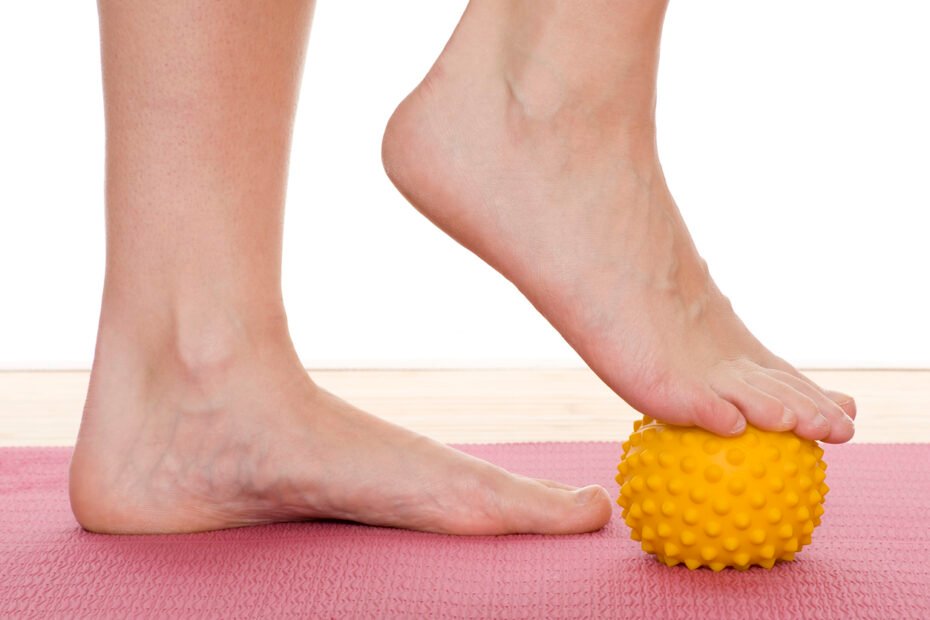Plantar Fasciitis is a common foot condition that can cause severe pain and discomfort. It is caused by the inflammation of the plantar fascia, which is the thick band of tissue that connects the heel bone to the toes at the bottom of the foot. Foot health, including the sole of the foot, plays an essential role in our overall well-being, and neglecting it can have severe implications. If you are experiencing pain in your feet, Plantar Fascia Ball Rolling might be a good idea and solution for you.
In this blog post, we will explore what Plantar Fasciitis is, how it affects our feet, and why foot health, specifically the sole of the foot, is crucial. We will also cover how Plantar Fascia Ball Rolling can help relieve pain and small tears, as well as other home remedies to manage this condition at home. Lastly, we will discuss when to seek professional help and if Plantar Fascia Ball Rolling is a solution for everyone, especially after a prolonged period of time spent non-weight bearing.
Understanding Plantar Fasciitis
Understanding Plantar Fasciitis: Plantar fasciitis arises from micro-tears in the plantar fascia, leading to heel pain. Overuse or excessive pressure on the foot can cause this condition, resulting in morning discomfort and potential development of heel spurs and knee pain.
Causes of Plantar Fasciitis
Causes of plantar fasciitis include repetitive strain on the foot arch, unsupportive footwear, tight calf muscles, sudden increases in physical activity, and obesity. The condition is prevalent among active individuals.
Symptoms of Plantar Fasciitis
Symptoms of plantar fasciitis, includes pain in the heel and arch, worsened after rest or activity. Stiffness, tenderness, and aching in the foot, especially when climbing stairs or standing. Pain in the ball and arch of the foot.

Importance of Foot Health
Proper foot care is crucial for maintaining balance, posture, and body alignment, preventing painful conditions, and preserving an active lifestyle. Neglecting foot health can lead to long-term mobility issues and pain.
Role of Foot Health in Overall Well-being
Good foot health contributes to overall physical and mental well-being. Proper care prevents chronic pain, enhances balance, stability, and supports an active lifestyle. It also impacts posture, comfort, and agility.
Implications of Ignoring Foot Health
Ignoring foot health may lead to painful conditions, decreased mobility, discomfort, and increased risk of complications and deformities over time. This can significantly impact an individual’s quality of life.
Introduction to Plantar Fascia Ball Rolling
Experience relief from plantar fasciitis pain with self-massage using a tennis or lacrosse ball to target affected foot muscles for improved flexibility and reduced tension.

Benefits of Plantar Fascia Ball Rolling
Reducing muscle tension and promoting relaxation, enhancing blood circulation for healing, myofascial release, improved flexibility, and complementing other treatment modalities for plantar fasciitis.
How Plantar Fascia Ball Rolling Helps in Pain Relief
Targeting specific trigger points, this technique provides localized pain relief, stimulates endorphin release, and aids in tissue healing and muscle relaxation for plantar fasciitis relief.
Implementing Plantar Fascia Ball Rolling into Your Routine
Incorporate plantar fascia ball rolling to manage foot pain. Perform daily for optimal benefits and integrate into existing foot care regimen for enhanced relief. Combine with other holistic treatment approaches.
Ideal Time for Plantar Fascia Ball Rolling
After physical therapy, before bedtime, or anytime, rolling a ball under the foot for plantar fasciitis helps relieve pain and discomfort. Using a frozen water bottle post-therapy can also be beneficial.
Duration of Each Session
For effective relief, rolling foot on a ball for plantar fasciitis should be done for 5-10 minutes per affected foot, alternating sides. Each session should not exceed 20 minutes.
Techniques of Plantar Fascia Ball Rolling
Rolling the foot on a ball for plantar fasciitis involves applying enough pressure to focus on the arch, targeting the sole, heel bone, and affected foot muscles. A frozen water bottle can be used for pain relief.
Click here for a brief video demonstration of plantar fascia ball rolling with technique tips.
Correct Posture and Pressure for Effective Results
Maintain correct posture when rolling foot on ball for plantar fasciitis relief. Apply ample pressure, focusing on the arch, for effective results in pain relief.
Common Mistakes to Avoid
When rolling foot on a ball for plantar fasciitis, avoid poor posture to prevent exacerbating the condition. Ineffective relief may result from insufficient pressure and excessive discomfort caused by excessive pressure.
Other Home Remedies for Plantar Fasciitis
When dealing with plantar fasciitis, consider stretching exercises, ice therapy, and wearing the right footwear. Professional help should be sought if symptoms persist.
Stretching Exercises
Stretching exercises play a crucial role in improving flexibility and reducing tension in the plantar fascia. They can complement shockwave therapy and massage therapy for enhanced pain relief and foot health.

Ice Therapy
Applying ice reduces inflammation and soothes painful foot. It’s an effective NLP treatment to complement plantar fascia ball rolling therapy.
Importance of Wearing the Right Footwear
Choosing proper footwear is crucial for foot health. The right shoes provide arch support, lessen pain, and can be complemented with custom orthotics for maximum comfort and relief. Shockwave therapy may also benefit.
Professional Help for Plantar Fasciitis
When seeking professional help for plantar fasciitis, consider shockwave therapy, massage therapy, night splints, or custom orthotics for optimal recovery and pain management.
When to Consult a Professional?
If you experience persistent or severe foot pain, it’s a good idea to consult a healthcare professional. They can diagnose and treat plantar fasciitis and provide guidance on proper techniques for plantar fascia ball rolling. If you have a history of foot injuries or medical conditions, such as pain in the ball of your foot or issues with your achilles tendon or arch of your foot, it’s a good idea to consult with your doctor before starting any new foot health routines or treatment plans.

Is Plantar Fascia Ball Rolling a Solution for Everyone?
Plantar Fascia Ball Rolling can be beneficial for many, but it’s not a one-size-fits-all solution. Consulting a healthcare professional is crucial before trying any new treatment, including tennis ball massage, deep tissue massage, foot massage, and other massage techniques. However, it can be particularly helpful for individuals with plantar fasciitis or other foot-related conditions. A personalized approach based on individual needs and medical history, including the integration of deep tissue massage and foot massage, is recommended.
Are there any risks or precautions to consider when using a ball roller for plantar fasciitis?
When it comes to using a ball roller for plantar fasciitis, it’s important to take certain precautions. Consult a healthcare professional before starting, gradually increase pressure, avoid using if you have an open wound or infection, and stop if you experience pain or discomfort.
What other exercises or treatments can be used in conjunction with ball rolling for plantar fasciitis?
To complement ball rolling for plantar fasciitis, incorporate stretching exercises for the calf muscles. Supportive footwear and avoiding high impact activities can prevent further irritation. Ice therapy and massage can also provide relief. Consult a healthcare professional for personalized treatment recommendations.

Conclusion
In conclusion, taking care of your foot health is essential for overall well-being. Ignoring foot health can lead to various problems, including plantar fasciitis. Plantar fascia ball rolling is an effective technique that can help alleviate pain and provide relief. By incorporating this practice into your routine, you can improve the flexibility and strength of your foot muscles. Remember to maintain the correct posture and pressure while rolling the ball to achieve optimal results.
Additionally, it is important to complement plantar fascia ball rolling with other home remedies such as stretching exercises, ice therapy, and wearing the right footwear. If your symptoms persist or worsen, it is advisable to seek professional help. Take care of your feet, and they will support you in leading a healthy and active lifestyle.
I hope you found this blog helpful and please feel free to comment and share.
Thanks for reading!
 | Tracy J. Founder, The heel GP |
